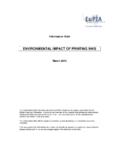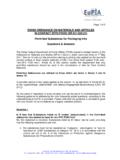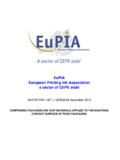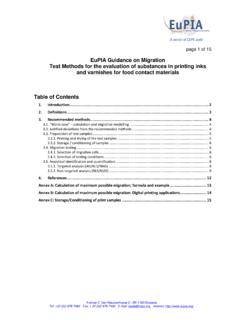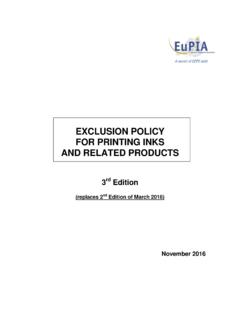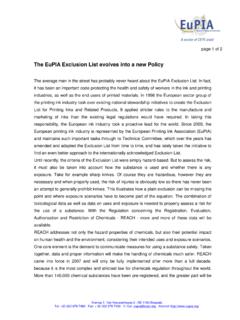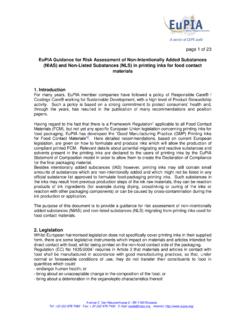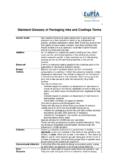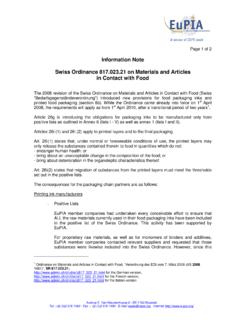Transcription of 100913 Swiss Ordinance on Packaging Inks FAQ …
1 Federal Department of Home Affairs FDHA. Federal Office of Public Health FOPH. Consumer Protection Directorate Page 1 of 4. Swiss Ordinance on Packaging Inks Substance Evaluation and Detection Limits: Frequently Asked Questions Following a number of points for clarification received from several stakeholders, this FAQ. document issued jointly by FOPH and EuPIA has been compiled to provide further information and guidance as to the effective operation of the Swiss Ordinance (SR ) as it relates to Packaging inks. Q1. A number of substances evaluated and approved by EFSA for use in food contact materials did not appear in the initial public version of Annex 1 and Annex 6 (dated 25.)
2 November 2009). Will FOPH accept EFSA evaluated substances with their derived Specific Migration Limits (SMLs)? Yes, EFSA evaluations are accepted. A revised version of Annex 6 is being prepared which incorporates the recent EFSA published evaluations together with the relevant restrictions where appropriate. The Annex 6 revision also includes some information for substances listed in the former Synoptic Document. Q2. Will it be permissible to use the EFSA SML until such time as Annex 6 is amended, and how will these new migration limits be communicated in the interim? The EFSA published SMLs can be used.
3 Current practice in Switzerland requires that enforcement authorities ask for the most recent information from the FOPH, before measures are taken regarding migration levels; enforcement laboratories will not enforce contrary to an EFSA. decision. New migration limits and restrictions will be communicated in official information letters published by the FOPH and made available on their website. Q3. Will FOPH recognise evaluations carried out by other bodies? Yes, evaluations by other official authorities will be acceptable provided that these are carried out according to Good Practices. Q4. Will FOPH recognise evaluations by expert toxicologists?
4 These will probably be acceptable, following assessment by FOPH expert toxicologists and review of the toxicological data on which the evaluation has been based. For mutagenicity data to support a migration limit of mg/kg food (50 ppb) the source of the information, and at least a summary of the test results has to be provided. Avenue E. Van Nieuwenhuyse 6 - BE-1160 Brussels Tel: +32 (0)2 676 7480 - Fax: + 32 (0)2 676 7490 - E-mail: - Internet: Federal Department of Home Affairs FDHA. Federal Office of Public Health FOPH. Consumer Protection Directorate Page 2 of 4. Q5. Will FOPH accept the use of additional uncertainty factors, as described in REACH.
5 Technical guidance Chapter R8, to allow for extrapolation/read across of toxicity data from different exposure routes and study durations? Under certain conditions, extrapolation from different exposure routes or times is possible. For instance, if only a 28-day study is available instead of a 90-day study, extrapolation from subacute to chronic exposure is possible using an additional assessment factor. This factor depends on the quality of the study and is chosen on a case-by-case basis. Q6. Can a missing in-vitro genotoxicity test be compensated for by two favourable in-vitro tests and an absence of structure alerts, when supported by additional repeat dose data and read across from similar substances?
6 Principally, three in-vitro genotoxicity tests are required for the evaluation and approval of substances in food contact materials. Under certain conditions, only 2 in-vitro mutagenicity studies will be available, for new chemical substances notified under the EU ELINCS. system up to 100 T/a. In this situation, both in-vitro genotoxicity tests (one mutation test, one clastogenicity test) have to be negative and the absence of structural alerts for potential genotoxicity has to be shown to support a migration limit of mg/kg. Instead of absence of structural alerts for potential genotoxicity, it can be shown that genotoxicity is not probable by read-across from structurally-related compounds.
7 Additional repeat dose data will not help to clarify the genotoxicity profile of a substance. In case of a positive in-vitro genotoxicity test, a corresponding in-vivo genotoxicity study will be required to disprove this effect. Q7. Will FOPH accept the use of data, study summaries and evaluations from reputable sources such as OECD HPV, SIDS/SIAR/SIAM, REACH-IT, IUCLID, etc? Data evaluated under the HPV programme by official competent authorities should be acceptable. Data that has not been evaluated and held in repositories will require assessment As a matter of principle, the higher the expected migration limit, the more demanding are the requirements on the data.
8 Reported toxicological end-points or study summaries may not provide sufficient information to derive a robust migration limit, without recourse to the full study. Q8. How long is an evaluation expected to take? If all the data is available, and there are no complications, an evaluation should take approximately one month. However, this process can take much longer if a dialogue with the notifier is required, or if additional data has to be generated. The evaluation is done by two FOPH toxicologists, without a further committee procedure. Avenue E. Van Nieuwenhuyse 6 - BE-1160 Brussels Tel: +32 (0)2 676 7480 - Fax: + 32 (0)2 676 7490 - E-mail: - Internet: Federal Department of Home Affairs FDHA.
9 Federal Office of Public Health FOPH. Consumer Protection Directorate Page 3 of 4. Q9. How many substance dossiers have been received and evaluated? Six new substances have been notified since March 2010, and one substance has been evaluated. Q10. When can a newly notified substance be placed on the market? A substance may be used as soon as the notifier has received confirmation of receipt of the dossier by the FOPH. Q11. Once the newly notified substance is placed on the market, what migration limits or restrictions apply in the interim period before the evaluation and decision from FOPH? The limit that is proposed in the dossier is accepted ad interim.
10 Q12. Similarly, what limits should apply to the substances listed in Information Note No 153? No limits are specified, but it will depend on the limit proposed in the justification for re- evaluation: the decision will have to be taken case by case. Once the re-evaluation of these substances is complete, the migration limits will be published and made available to the enforcing laboratories. Q13. Art. 26g of the Regulation requires that Packaging inks may only be manufactured from substances listed in Annex 1 and in Annex 6. Does this require that substances are listed in both Annex 1 and Annex 6? This is an unfortunate mis-interpretation arising from translation.
